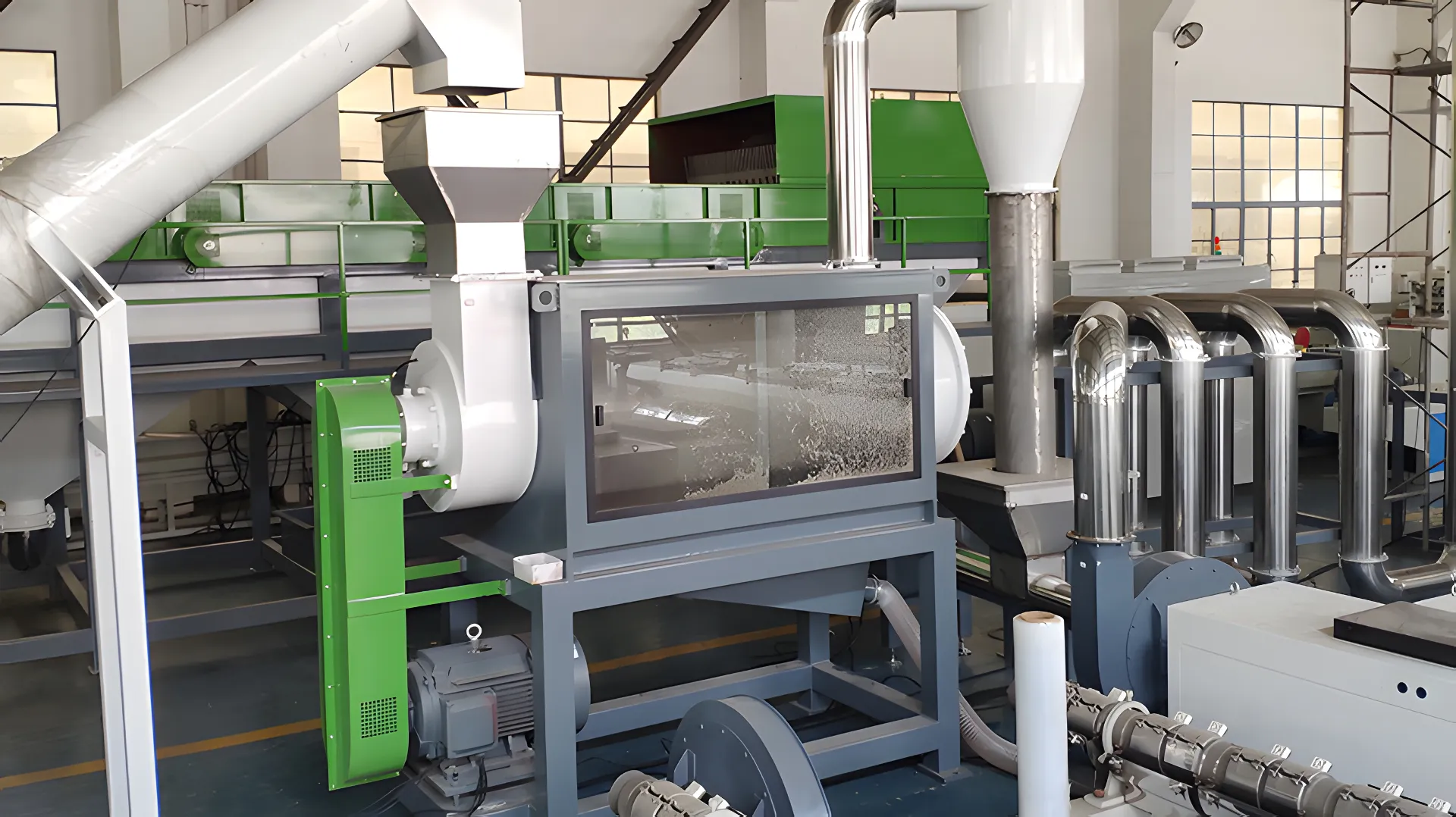Úvod: Výzva mokrých plastů
Ve světě recyklace plastů je vlhkost nepřítelem. Ať už zpracováváte promyté plastové vločky nebo drcený materiál, přebytečná voda může zpomalit výrobu, ohrozit kvalitu konečného produktu a zvýšit náklady na energii. Jak tedy tento běžný problém vyřešit?
Zadejte Odstředivý sušicí odvodňovací strojToto výkonné zařízení je převratným nástrojem pro jakoukoli linku na zpracování plastů a je navrženo tak, aby rychle a efektivně odstraňovalo vodu. V této příručce se podrobně ponoříme do toho, co tyto stroje jsou, jak fungují a proč jsou pro váš provoz nezbytnou investicí.
Dekódování odvodňovacího stroje odstředivé sušičky
Představte si high-tech, průmyslový odstředivý lis na salát, ale z plastu. V jádru... odvodňovací stroj s odstředivou sušičkou je mechanická sušička, která využívá obrovskou rotační sílu k oddělení vody od plastových materiálů, jako jsou PET vločky, PE/PP fólie a další tuhé plasty.
Na rozdíl od termických sušiček, které se spoléhají na teplo (což může být pomalé a energeticky náročné), odstředivá sušička fyzicky odvádí vodu od plastových částic. Tento proces dramaticky snižuje obsah vlhkosti během několika sekund a dokonale připravuje materiál na další fázi, jako je extruze nebo peletizace.
Věda, která stojí za rotací: Jak to funguje krok za krokem
Kouzlo odstředivé sušičky spočívá v jejím jednoduchém, ale účinném principu. Zde je rozpis procesu:
Podávání materiálu: Mokré plastové vločky nebo částice jsou přiváděny do vstupu stroje, obvykle pomocí šnekového dopravníku, a vstupují do vertikální nebo horizontální komory.
Vysokorychlostní rotace: Uvnitř komory se centrální rotor s připojenými lopatkami otáčí velmi vysokými rychlostmi (obvykle přes 1 500 otáček za minutu).
Odstředivá síla v akci: Tento intenzivní rotační pohyb vytváří silnou odstředivou sílu. Ta tlačí plastový materiál proti válcovému sítu, které obklopuje rotor.
Oddělování vody: I když jsou pevné plastové částice příliš velké na to, aby prošly perforací síta, voda je násilím vytlačována skrz drobné otvory a shromažďována na dně pro odtok.
Vypouštění suchého materiálu: Nyní odvodněný plast pokračuje ve své cestě podél rotoru a je vypouštěn z výstupu, připraven k dalšímu zpracování s výrazně nižším obsahem vlhkosti.
Klíčové komponenty, které to umožňují
Rotor s lopatkami: Srdce stroje, zodpovědné za otáčení materiálu vysokou rychlostí.
Perforované síto: Odolná válcová síťovina, která umožňuje odtok vody a zároveň zachovává plast.
Motor s vysokým točivým momentem: Pohonný mechanismus, který pohání rotaci rotoru a zajišťuje konzistentní rychlost a sílu.
Vstupní a výstupní porty: Umožňují nepřetržitý tok materiálu systémem, což je ideální pro integraci do kompletní mycí linky.
Robustní pouzdro: Obalí všechny komponenty, zajišťuje bezpečný provoz a svádí vytékající vodu do sběru.
Nepřekonatelné výhody odstředivého odvodňování
Integrace odstředivé sušičky do vaší recyklační linky nabízí řadu výhod, které přímo ovlivňují vaši efektivitu a hospodářský výsledek.
Bezkonkurenční rychlost a propustnost: Dramaticky zkracuje dobu schnutí z hodin na minuty, eliminuje úzká hrdla ve výrobě a zvyšuje celkový výkon.
Vynikající kvalita konečného produktu: Rychlým snížením obsahu vlhkosti (často pod 1,51 TP3T) se zabraňuje problémům, jako je bublání a degradace během extruze, což vede k kvalitnějším a hodnotnějším plastovým peletám.
Významné úspory energie: Tyto stroje spotřebovávají mnohem méně energie ve srovnání s tradičními sušicími systémy založenými na teple, což vede k nižším provozním nákladům a ekologičtější stopě.
Kompaktní rozměry: Odstředivé sušičky jsou relativně kompaktní, takže je lze snadno integrovat do stávajících recyklačních linek, aniž by vyžadovaly velké množství podlahové plochy.
Kde se odstředivé sušičky nejlépe projevují? Klíčové aplikace
Tyto všestranné stroje jsou nepostradatelné v celé řadě odvětví zpracování plastů:
Linky na recyklaci PET lahví: Nezbytné pro odvodnění drcených PET vloček po fázích praní a oplachování.
Recyklace PE/PP fólie a sáčků: Účinně odstraňuje vodu z lehkých, tenkých fóliových materiálů, které se obtížně schnou.
Recyklace tuhých plastů: Ideální pro sušení drti z materiálů jako HDPE, ABS a PS.
Pro bližší pohled na to, jak jsou tyto stroje integrovány do kompletního systému, si můžete prohlédnout naši Odstředivá sušička odvodňovací stroj pro sušení plastů řešení a uvidíte je v praxi.
Udržování stroje v perfektním stavu: Základy údržby
Aby vaše odstředivá sušička fungovala bezchybně a měla dlouhou životnost, stačí trocha pravidelné údržby.
Denní kontrola obrazovky: Pro zajištění účinného odstranění vody rychle zkontrolujte síto, zda není ucpané.
Pravidelné čištění: Rotor a síto důkladně čistěte jednou týdně nebo každé dva týdny, abyste zabránili hromadění materiálu.
Mazání ložisek: Dodržujte plán mazání ložisek motoru a rotoru od výrobce, aby se vše plynule otáčelo.
Kontrola opotřebení: Pravidelně kontrolujte lopatky rotoru a síto, zda nevykazují známky opotřebení, a v případě potřeby vyměňte součásti, abyste zachovali jejich výkon.
Často kladené otázky (FAQ)
1. Jak moc lze plast sušit v odstředivé sušičce?
Vysoce kvalitní odstředivá sušička dokáže obvykle snížit obsah vlhkosti na hodnotu mezi 11 TP3T a 2,51 TP3T, což je ideální pro většinu následných procesů, jako je peletizace.
2. Lze jej použít pro všechny druhy plastů?
Ano! Jsou neuvěřitelně všestranné a efektivně fungují na široké škále materiálů, včetně tvrdých plastů jako PET a ABS, a také měkkých plastů, jako jsou PE/PP fólie.
3. Co mám dělat, když je stroj ucpaný?
Nejprve vždy vypněte stroj a dodržujte bezpečnostní postupy pro odblokování. Poté otevřete přístupový panel a zkontrolujte síto a rotor, zda nejsou ucpané. Pokud problém nedokážete snadno vyřešit, nahlédněte do uživatelské příručky nebo kontaktujte náš tým podpory.
4. Jak často je třeba vyměňovat obrazovku?
To závisí na abrazivnosti zpracovávaného materiálu a na vašich provozních hodinách. Při správném čištění a údržbě může vysoce kvalitní síto vydržet velmi dlouho, ale mělo by být pravidelně kontrolováno, zda není opotřebované.
Závěr: Investice do efektivity a kvality
A odvodňovací stroj s odstředivou sušičkou je více než jen kus vybavení; je to strategická investice do efektivity, ziskovosti a kvality vašeho provozu recyklace plastů. Rychlým a nákladově efektivním odstraňováním vlhkosti zefektivňuje celý váš proces, zvyšuje propustnost a zajišťuje produkci vynikajícího konečného produktu.
Jste připraveni odstranit úzká hrdla a posunout sušení plastů na další úroveň? Kontaktujte nás ještě dnes dozvíte se více o našich robustních a spolehlivých odstředivých sušičkách a najdete perfektní řešení pro vaše potřeby



